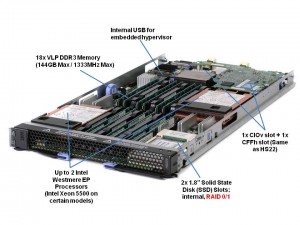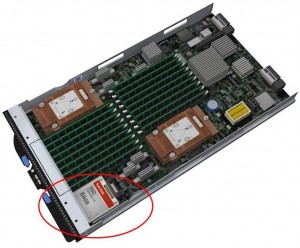IBM officially announced today a new addition to their blade server line – the HS22v. Modeled after the HS22 blade server, the HS22v is touted by IBM as a “high density, high performance blade optimized for virtualization.” So what makes it so great for virtualization? Let’s take a look.
 Memory
Memory
One of the big differences between the HS22v and the HS22 is more memory slots. The HS22v comes with 18 x very low profile (VLP) DDR3 memory DIMMs for a maximum of 144GB RAM. This is a key attribute for a server running virtualization since everyone knows that VM’s love memory. It is important to note, though, the memory will only run at 800Mhz when all 18 slots are used. In comparison, if you only had 6 memory DIMMs installed (3 per processor) then the memory would run at 1333Mhz and 12 DIMMs installed (6 per processor) runs at 1066Mhz. As a final note on the memory, this server will be able to use both 1.5v and 1.35v memory. The 1.35v will be newer memory that is introduced as the Intel Westmere EP processor becomes available. The big deal about this is that lower voltage memory = lower overall power requirements.
Drives
The second big difference is the HS22v does not use hot-swap drives like the HS22 does. Instead, it uses a 2 x solid state drives (SSD) for local storage. These drives have hardware RAID 0/1 capabilities standard. Although the picture to the right shows a 64GB SSD drive, my understanding is that only 50GB drives will be available as they start to become readlily available on March 19, with larger sizes (64GB and 128GB) becoming available in the near future. Another thing to note is that the image shows a single SSD drive, however the 2nd drive is located directly beneath. As mentioned above, these drives do have the ability to be set up in a RAID 0 or 1 as needed.
does. Instead, it uses a 2 x solid state drives (SSD) for local storage. These drives have hardware RAID 0/1 capabilities standard. Although the picture to the right shows a 64GB SSD drive, my understanding is that only 50GB drives will be available as they start to become readlily available on March 19, with larger sizes (64GB and 128GB) becoming available in the near future. Another thing to note is that the image shows a single SSD drive, however the 2nd drive is located directly beneath. As mentioned above, these drives do have the ability to be set up in a RAID 0 or 1 as needed.
So – why did IBM go back to using internal drives? For a few reasons:
Reason #1 : in order to get the space to add the extra memory slots, a change had to be made in the design. IBM decided that solid state drives were the best fit.
Reason #2: the SSD design allows the server to run with lower power. It’s well known that SSD drives run at a much lower power draw than physical spinning disks, so using SSD’s will help the HS22v be a more power efficient blade server than the HS22.
Reason #3: a common trend of virtualization hosts, especially VMware ESXi, is to run on integrated USB devices. By using an integrated USB key for your virtualization software, you can eliminate the need for spinning disks, or even SSD’s therefore reducing your overall cost of the server.
Processors
So here’s the sticky area. IBM will be releasing the HS22v with the Intel Xeon 5500 processor first. Later in March, as the Intel Westmere EP (Intel Xeon 5600) is announced, IBM will have models that come with it. IBM will have both Xeon 5500 and Xeon 5600 processor offerings. Why is this? I think for a couple of reasons:
a) the Xeon 5500 and the Xeon 5600 will use the same chipset (motherboard) so it will be easy for IBM to make one server board, and plop in either the Nehalem EP or the Westmere EP
b) simple – IBM wants to get this product into the marketplace sooner than later.
Questions
1) Will it fit into the BladeCenter E?
YES – however there may be certain limitations, so I’d recommend you reference the IBM BladeCenter Interoperability Guide for details.
2) Is it certified to run VMware ESX 4?
YES
3) Why didn’t IBM call it HS22XM?
According to IBM, the “XM” name is feature focused while “V” is workload focused – a marketing strategy we’ll probably see more of from IBM in the future.
That’s it for now. If there are any questions you have about the HS22v, let me know in the comments and I’ll try to get some answers.
For more on the IBM HS22v, check out IBM’s web site here.
Check back with me in a few weeks when I’m able to give some more info on what’s coming from IBM!